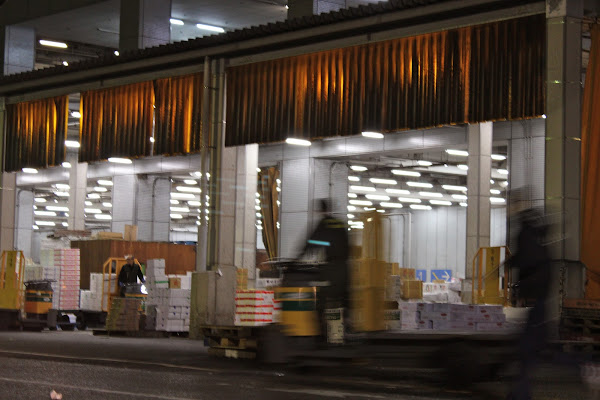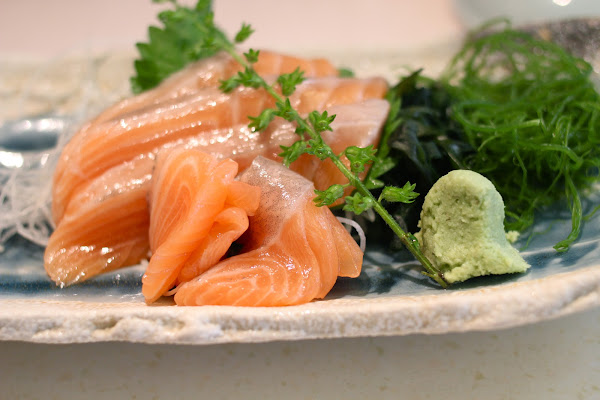While on holiday in Japan, I kept a detailed series of notes in
honour of Nanowrimo. All posts about Japan comprise excerpts from my
journals.
9th November 2013, Saturday
"... It's happening. It's actually happening. We are getting into Tsukiji Fish Market's tuna auction.
Where I work, we went through a week long series of lessons where we showed our students the documentary Jiro Dreams of Sushi. It's a beautiful film and we were all transfixed. But while everyone oohed and aahed at the gleaming slivers of fish that Jiro put on the table, I was most excited by the tuna auction. The first time I watched that segment, I sat up straight with great interest and told my students afterwards, "Look, look how they cart the fish out with hooks? And see what he's going there, putting a bit of a dance into his auctioneering?"
I've been dreaming of coming to the tuna auction for a long time. When I first told my mother, she stared at me like I was crazy and said that we would have to wait in the cold from 2am and that there were huge snaking lines and a limited number of tickets that would probably run out. Then, she saw the look on my face and said, "Well, if you really want to go, I'll come with you." My mother FTW!
So here we are, having had some very patchy sleep at 8pm, rousing ourselves now at 1:30am, a time when I'm normally just nodding off. But I am wired as hell, changing my lenses, checking my SD card, wrapping up in layers of Uniqlo Heattech. My mother is grumpy but resolute.
The story goes like this. Tsukiji Fish Market (and Wholesale Centre) was built decades ago but since it's gained notoriety, the market has gotten so crowded that the ageing infrastructure can't really handle the throngs of new visitors, so much so that the market will be dismantled in a couple of years. The tuna auction in particular, started bringing in so many people that it disrupted business and authorities put a cap on the number of visitors and limited viewing to two measly twenty minute time slots from a specified "visitor observation area".
As such, even though the visitor registration officially opens at 5am, people start queuing for the first-come-first-serve privilege from as early as three or four. Because it's a Saturday and our only chance, my mother is making us queue at two. Go big or go home, am I right?
We wrap up warmly, drink some hot water and go down to get specific instructions from the hotel concierge. Because we're staying in Ginza, Tsukiji is just a fifteen minute walk away. The concierge, a smiling young man, gives us a map then studies us in our bundled up state and hides his smile. "This time of the night, you are very..." he presses his lips together, "safe. You will definitely get tickets." He must think we are overeager schmucks.
We start walking down Harumi Street, looking for a way into the market. My mother and I are not queuers. We've never, in a typical Singaporean fashion, queued for anything. So, when we show up at the fabulously-named Fish Information Centre (I have a mental image of people coming to enquire about missing fish) and realise that we're the only ones here, the first in line, we are disbelieving.
"Don't worry," says the amused Fish Information Guard, "just wait here," and goes back inside where one of his companions is actually snoozing.
It's so early that people are still straggling out of bars clinging to each other. One woman sings loudly, waving her arms as her older partner grabs and shushes her. Japanese salarymen are still cycling home, briefcases in their bicycle baskets. One man, the beer rolling off him in waves, stops his bike and comes over in surprise to ask us what we're doing. "Maguro!" he roars in delight at the absurdity of it and mimes chopping the head off a fish.
The market, however, is just awakening. It's already packed with trucks rumbling merchandise in and out of the warehouses and nifty little forklifts with spinning lights that curl deftly round corners.
My mother hunkers down by the wall to get some shut eye and I read the rules mapped out on a board. The tuna auction is serious business and the authorities try to make it seem like they'll throw you out at the slightest provocation so that visitors are well-behaved. The signboard reads, "No sandals. No pets. No smoking. No food and drink. No making signals like raising your hand above your head. Be careful not to slip and fall. No big bags. No flash photography."
A note somewhere suggests that at one time, flash photography briefly blinded the auctioneers, causing them to miss important bids, a thought that sends me off into fits of laughter. I briefly contemplate leaping into the fray and bidding on a massive tuna but I remember reading somewhere that the most expensive one sold for thousands of dollars, so I decide against it.
At three, the next batch of queuers arrives: a couple from San Francisco. "Wow", the man says when we tell him what time we started. He is impressed by our dedication. Maybe we are good Singaporeans after all.
At three thirty, the line has built up to about thirty people. There is only room for ninety more. It's getting cold and a bit draughty. The Fish Information Guard sees us hopping around to keep warm and decides to open registration. They open a holding room and beckon us inside. Each visitor is given a map, a list of rules and a neon yellow visitors' vest. We get ushered to the front of the room and the places starts to fill up until it spills over into the second batch of visitors who are wearing green vests. It's only 3:40am and the first slot opens at 5:25am.
My mother stares at me in dismay, as if realising her folly for the first time. But hah! Too late! We are in! We all hold on to our dignity for about ten minutes, everyone insisting they will stand, but start collapsing to the ground one by one till everyone is in a sleep deprived heap on the floor. People lean on each other; some even try to curl up on the floor and get shut eye. An hour in, one of the Americans works out how to open some air vents, sending cool air wafting over all 120 of us. The room gives him an ovation. Every now and then, the guards come in and glare sharply at us.
It's like being in a refugee camp except that in this camp, I have the luxury of whiling the time away by reading five chapters of The Shadow of the Wind on Kindle (excellent so far!). Finally, finally it's 5:15am and people start to struggle to their feet, stretching and shaking out cramps.
I am suddenly wide awake, filled with adrenaline, realising I only have about twenty minutes to get photos. Just be calm and look alive, I tell myself, and don't beat yourself up for what you shoot or miss. I only have one plan - to try and get close to the floor.
At 5:25am, the guards unlock the doors, unpenning us and scowling as we spill out of the room. All the rules and glaring have worked because we file, meek as sheep, across the market. Work is in full swing here, the air replete with the swinging and ringing of bicycles and the little fish transporting buggies. The workers don't care about stupid visitors who've come to gawk at them - they just want to get their fish in chop chop - and we are almost run over several times.
We finally cross all the roads, start walking past the warehouses and through one door, I glimpse the pale, fat bodies of frozen tuna and let out a squeal. (Other girls squeal at Chanel, I squeal at... fish.) We are guided into one warehouse, into a makeshift observation area that is essentially a walkway in between two segments of the auction, cordoned off by crates. The visitors, silent and obedient, spread out along the walkway. We are careful to keep our hands to ourselves. Being among the shorter people, I shimmy to the front of the crowd and make myself as small as possible.
The men (this is a solely single sex arena here) walk around laughing and chatting as if it were a pub, except that the floor is lined with rows of frozen solid, gape-mouthed tuna (and what look like four massive fresh ones in the corner).
Each of them holds an iron rod with a hook on the end and a powerful flashlight. I wonder if they sell them tuna approved. They walk round the tuna, examining it from each angle. There is a slit cut in each belly and a flap of flesh cut close to the tail that folds back like a hinge.
All the tuna tails and fins have been hacked off (to save space, I assume) and I can see the great ring at the base of the backbone that is a cross section of its spine and the circles of fat that surround it.
The men bend and lift the tail flaps, shining the light on the flesh, and then prod at it with their hooks. If they seem satisfied, they make quite a brutal hack into the frozen meat, pull out a piece and squeeze it between their fingers as they check it under the light. One elderly man keeps digging his hook into the tail and attempting to lift the fish on one end for no apparent reason.
After about fifteen minutes of this, one group of auctioneers grabs hold of wooden pallets, climbs on top of them and starts ringing a bell.
The bell ringing starts slowly then gets more and more quick until it is a frenzied jingling in the air. From where I am standing, I can only see one guy clearly. And when the bell-ringing reaches its peak, he dampens it abruptly, sweeps his baseball cap off his head and bows and starts auctioning.
The three auctioneers going at once have deeply individual rhythms and patterns and they each seem to have a signature style. My guy shouts three times in rapid succession, flashing his palm between each shout and then shoots his hand up in the air before repeating the process. In front of him, four assistants note the bids rapidly, which is confusing to me because I barely see any bidding. Occasionally, one of the men milling about the floor disinterestedly raises a hand or makes vague air quotes, but I don't see a whole lot of frenzied fighting.


Obviously I'm missing something because when the bidding ends, men walk about slapping "bought" labels on each fish with water, which will stick them onto the iced over skin.
Then there is a hurry to cart the fish off before the next auction; the wholesalers dig their hooks into the tuna and simply drag them across the floor which probably has no effect on their rock hard flesh. Some use the hooks as holds on either end of the tuna and swing entire carcasses up onto carts which they pull away like rickshaws.
We are unceremoniously shuffled off the floor along with the fish although now that we have adhered to every rule and proven ourselves worthy visitors, the pretence at sternness is abandoned. The guards cheerfully lead us away from the warehouses, take our neon vests and dismiss us with smiles.
In reality, nothing much as happened but I'm humming with energy and delight because of what I've just witnessed. The air is somehow colder than when we got here and shivering, my mother and I duck into the nearest sushi joint and order a beautifully fresh platter of sashimi and ikura don. The place, a tiny, cramped family restaurant, is already packed at six a.m. with customers having morning sushi and beer.
A man from Yokohama chats with us and kindly asks if he can take our picture, so we oblige and talk a little bit with him. He's been to Singapore, he says, and "looooves" the chicken rice and, of all things, durians. We eat till we are stuffed, the last ikura pearls bursting in our mouths, then thank the bosslady, the man from Yokohama (and in my heart, the Universe, the morning, life) and full and finally flagging, start back for the hotel.
The air is colder and crisper than before. In a briny haze, we tumble back into bed and in a sweet languor induced by full bellies, take a massive, fish fuelled nap."





















































